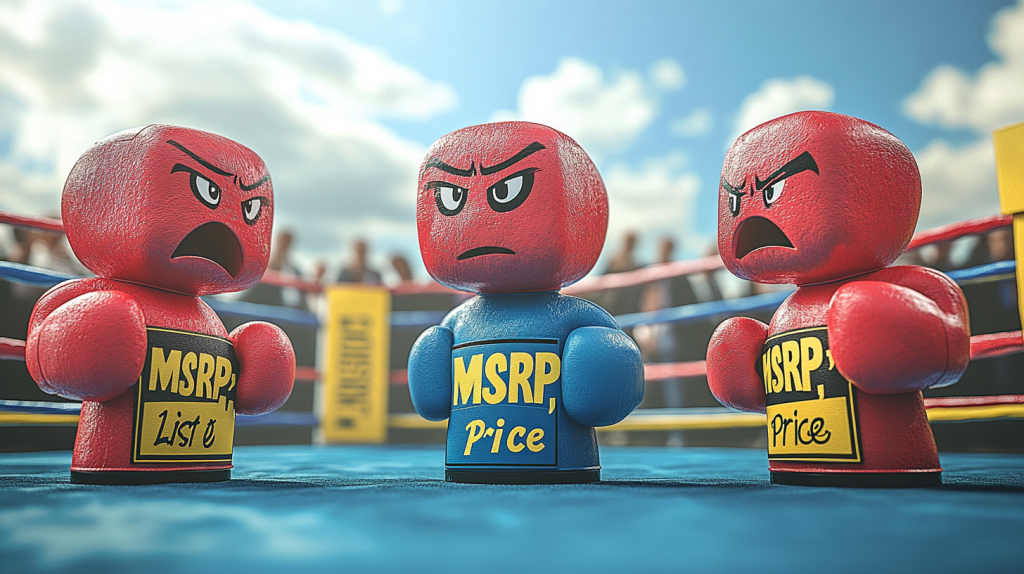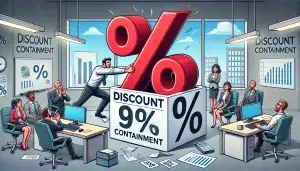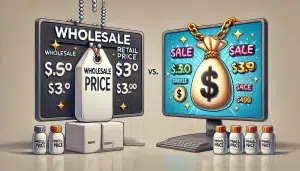
Table of Contents
- What RRP Means
- The RRP Recipe: Cooking Up the Perfect Price
- RRP vs. MSRP: Acronym Showdown
- RRP Mastery: Strategies for E-commerce Wizards
- Myth Busters: RRP Edition
- A Day in the Life: RRP on the E-commerce Frontlines
- Pro Hacks: RRP Tricks of the Trade
- Oops! Common RRP Pitfalls and How to Dodge Them
- Crystal Ball Time: Future Trends in RRP
- My RRP Rollercoaster: A Personal Tale
- FAQs
- Useful Links
What RRP Means
RRP stands for Recommended Retail Price. It’s the price that a manufacturer suggests retailers sell a product for. This price is typically higher than the actual selling price, as retailers often offer discounts to attract customers. RRP serves as a benchmark for consumers to gauge the value of deals and promotions.
For you, the savvy e-commerce entrepreneur, understanding RRP is like finding the cheat code to level up your business. It’s the compass that guides your pricing strategy, helping you navigate the treacherous waters of competition, customer expectations, and profitability.
The RRP Recipe: Cooking Up the Perfect Price

Ever wondered how the bigwigs come up with these magical RRP numbers? It’s not just a game of eeny, meeny, miny, moe. Let’s peek behind the curtain and see what goes into this pricing potion:
- Production Costs: The bread and butter of pricing. This includes everything from the cost of raw materials to the wages of the workers who put the product together.
- Competitor Pricing: Because no one wants to be the odd one out at the pricing party.
- Consumer Demand: If people are willing to sell their kidneys for your product, you might as well price it accordingly (just kidding, please keep your organs).
- Retailer Markup: Gotta leave room for the middleman to make a buck too.
- Brand Positioning: Are you the Rolls-Royce or the Toyota of your industry? Your RRP should reflect that.
- Economic Factors: Inflation, currency fluctuations, and other economic voodoo that keeps economists up at night.
Here’s a mind-blowing stat for you: According to a study by McKinsey & Company, a mere 1% increase in price can lead to an 8.7% increase in operating profits. That’s like turning water into wine for your bottom line!
Now, you might be wondering, “How do I calculate RRP for my products?” Fear not, intrepid entrepreneur! Here’s a simple formula to get you started:
RRP = (Cost of Goods + Desired Profit Margin) / (1 - Retailer Markup Percentage)For example, if your product costs $50 to make, you want a 20% profit margin, and retailers typically mark up by 50%, your calculation would look like this:
RRP = ($50 + $10) / (1 - 0.5) = $120Voilà! You’ve just cooked up your very own RRP.
But remember, this is just a starting point. You’ll need to season it with market research and competitive analysis to get the perfect flavor.
RRP vs. MSRP: Acronym Showdown

Now, don’t get your pricing terms in a twist. RRP has a few cousins in the pricing family, and it’s crucial to know who’s who. Let’s break it down:
- RRP (Recommended Retail Price): The “suggestion” for what you should sell at. It’s like your mom telling you to wear a jacket – you can ignore it, but there might be consequences.
- MSRP (Manufacturer’s Suggested Retail Price): Essentially the same as RRP, just with a fancier name. It’s more commonly used in the US, while RRP is more common in the UK and Australia.
- SRP (Suggested Retail Price): Another term for RRP or MSRP. It’s like calling your grandmother “Nana” or “Granny” – different names, same lovely lady.
- List Price: The official price for a product, often used interchangeably with RRP or MSRP.
Why should you care about these distinctions? Because understanding the nuances can help you navigate the treacherous waters of pricing strategy without getting slapped with a manufacturer’s wet noodle. Plus, it makes you sound super smart at e-commerce cocktail parties (yes, that’s a thing).
RRP Mastery: Strategies for E-commerce Wizards
Ready to become an RRP sensei? Here are some ninja moves to add to your pricing repertoire:
- The Benchmark Boogie: Use RRP as your North Star, but don’t be afraid to dance around it. Sometimes, you gotta zig when others zag.
- Dynamic Pricing Dojo: Be like water, my friend. Adapt your prices in real-time based on market conditions. Tools like Pricefy can be your sidekick in this adventure.
- The Ethical Tightrope Walk: Stay on the right side of the law. No funny business with fake discounts or misleading prices. The pricing police are watching!
- Psychological Warfare: Use the power of the mind! Setting prices just below round numbers (like $9.99 instead of $10) can trick the brain into thinking it’s getting a better deal.
- Bundle Fu: Combine products in ways that make the RRP less relevant. It’s like creating your own unique dish that no one else can price compare.
Remember, grasshopper, the goal is to find the sweet spot where your prices are attractive to customers but still put noodles in your bowl.
And speaking of noodles, here’s some food for thought: A study by Deloitte found that 74% of consumers consider price to be the most important factor in their purchasing decisions.
So, your RRP strategy isn’t just about numbers – it’s about psychology, market positioning, and customer perception.
Myth Busters: RRP Edition
Time to put on our mythbuster hats and tackle some common RRP misconceptions:
- Myth: RRP is the law.
Truth: It’s more like a strong suggestion. You’re not going to jail for ignoring it (but you might end up in manufacturer timeout). - Myth: Always pricing below RRP is the key to success.
Truth: Race to the bottom? More like race to bankruptcy. Sometimes, higher prices can actually increase perceived value. - Myth: RRP is always inflated.
Truth: While some manufacturers play this game, many use RRP as a genuine guide for fair pricing. - Myth: Customers don’t care about RRP.
Truth: Oh, they care. It’s often used as a reference point for whether they’re getting a good deal. - Myth: RRP is the same globally.
Truth: Nope! RRP can vary wildly between countries due to taxes, import costs, and local market conditions.
Don’t let these myths lead you astray in your pricing odyssey! Remember, in the world of e-commerce, knowledge is power – and profit.
A Day in the Life: RRP on the E-commerce Frontlines

Picture this: You’re Sarah, owner of “Gadget Galaxy,” an up-and-coming online electronics store. Your alarm blares at 6 AM, and before you’ve even had your first sip of coffee, you’re checking competitor prices on your best-selling smartwatch.
Uh-oh. BigBoxMart is selling it for 10% below your price, which is already skating close to the RRP ice. Do you match their price and risk a pricing war? Stick to your guns and potentially lose sales? Or get creative with bundles and value-adds?
This, my friends, is the daily tango of e-commerce pricing. It’s a non-stop juggling act of RRPs, competitor moves, and customer expectations.
But fear not! With the right strategies (and maybe a few extra shots of espresso), you can turn this daily grind into a well-oiled machine.
Here’s how Sarah might navigate this RRP rollercoaster:
- Check the RRP: Is BigBoxMart’s price still within the acceptable range set by the manufacturer?
- Analyze the competition: Use Pricefy to know if this a temporary promotion or a long-term strategy?
- Crunch the numbers: Can you afford to match the price and still make a profit?
- Get creative: Could you offer a bundle deal or added value service to justify your higher price?
- Communicate with suppliers: Is there room for negotiation on your wholesale price?
- Monitor customer behavior: Are you losing sales, or are customers still willing to pay your price?
By the end of the day, Sarah might decide to slightly lower her price, but also offer a free extended warranty to justify the small premium over BigBoxMart.
It’s all about finding that sweet spot between competitiveness and profitability.
Pro Hacks: RRP Tricks of the Trade
Time for some ninja-level RRP hacks that’ll give you an edge:
- The High-Low Hustle: Set your regular prices at or slightly above RRP, then run frequent, deep discounts. It’s like a perpetual sale that keeps customers coming back for more.
- The Bundle Bonanza: Combine products in unique ways that make RRP comparisons difficult. It’s like creating your own secret menu items.
- The Value-Add Voodoo: Offer services or extras that justify a higher price. Free shipping, extended warranties, or VIP support can be your golden ticket.
- The Scarcity Scare: Limited time offers or exclusive deals can make customers forget all about RRP in their FOMO frenzy.
- The Transparency Triumph: Sometimes, being upfront about your pricing strategy and why you deviate from RRP can win customer trust.
Remember, the goal is to be clever, not sneaky. Keep it ethical, folks! And here’s a pro tip within a pro tip: According to a study by the Harvard Business Review, customers are willing to pay more for products from companies they trust.
So, building a reputation for fair pricing and transparency can actually boost your bottom line in the long run.
Oops! Common RRP Pitfalls and How to Dodge Them

Even the savviest e-commerce entrepreneurs can stumble. Here are some RRP potholes to watch out for:
- The Race to the Bottom: Constantly undercutting RRP can lead to a pricing war that nobody wins. Your margins will be crying for mercy.
- The Stagnation Station: Sticking rigidly to RRP without considering market changes is like using a flip phone in the smartphone era.
- The Discount Addiction: Always selling below RRP can devalue your brand faster than you can say “clearance sale.”
- The Comparison Conundrum: Forgetting to factor in shipping, taxes, and other fees when comparing your prices to RRP can lead to some nasty surprises.
- The Legal Landmine: Misrepresenting RRP or creating fake “was” prices can land you in hot water faster than you can say “class action lawsuit.”
Avoid these blunders, and you’ll be sailing smooth in the e-commerce seas! And remember, as the old saying goes, “Learn from the mistakes of others. You can’t live long enough to make them all yourself.”
Crystal Ball Time: Future Trends in RRP
Let’s gaze into the e-commerce crystal ball and see what the future holds for RRP:
- AI-Powered Pricing: Imagine RRPs that adjust in real-time based on global market conditions. It’s like having a pricing psychic on your team.
- Personalized RRP: RRPs tailored to individual customer profiles. Creepy or cool? You decide.
- Blockchain RRP: Transparent, tamper-proof RRP records. No more “he said, she said” in pricing disputes.
- Sustainable Pricing: RRPs that factor in environmental costs. Green is the new black, after all.
- Augmented Reality Pricing: Visualize different pricing scenarios in real-time. It’s like “Minority Report,” but for your wallet.
Remember, the future is not set in stone. But keeping an eye on these trends can help you stay ahead of the curve. And here’s some food for thought: A survey by Gartner predicts that by 2025, 80% of B2B sales interactions between suppliers and buyers will occur in digital channels.
FAQs
Q: What does RRP mean?
A: RRP stands for Recommended Retail Price. It’s the price that manufacturers suggest retailers should sell their products at.
Q: What is RRP in ecommerce?
A: In ecommerce, RRP serves as a pricing guideline for online retailers, helping them set competitive prices while maintaining profitability.
Q: What is RRP in the USA?
A: In the USA, RRP is more commonly known as MSRP (Manufacturer’s Suggested Retail Price) or List Price. The concept is the same as RRP.
Q: What does RRP mean on products?
A: When you see RRP on a product, it indicates the price the manufacturer recommends for selling that item. It’s often used to compare against the actual selling price.
Q: What does RRP do?
A: RRP serves several purposes:
– Enables retailers to show discounts when selling below RRP
– Provides a pricing guideline for retailers
– Helps maintain price consistency across different sellers
– Allows consumers to gauge the value of a product
Q: How to calculate RRP?
A: A common formula is: RRP = (Cost of Goods + Desired Profit Margin) / (1 – Retailer Markup Percentage). However, factors like market conditions and competition should also be considered.
Q: What is the purpose of the RRP?
A: The main purposes of RRP are:
– To allow room for retailer discounts while maintaining profitability
– To provide a consistent pricing strategy across different retailers
– To help consumers understand a product’s perceived value
Q: Is it illegal to sell products below cost?
A: While not inherently illegal, selling below cost consistently could be considered predatory pricing in some jurisdictions, which is illegal.
Q: What is the difference between RRP and retail price?
A: RRP is the manufacturer’s suggestion, while retail price is what the retailer actually charges. The retail price may be higher or lower than the RRP.
Q: Why is RRP important?
A: RRP helps maintain price consistency across different retailers, provides a reference point for consumers, and helps retailers set competitive prices.
Q: What does RRP mean in wholesale?
A: In wholesale, RRP helps wholesalers understand the potential retail value of the products they’re buying, which informs their own pricing strategies.
Q: What is the meaning of RRP in logistics?
A: In logistics, RRP is used for inventory valuation and pricing strategies. It helps in determining insurance values and can impact storage and handling decisions.
Q: What does average RRP mean?
A: Average RRP refers to the mean recommended retail price across different products in a category or across different sellers for the same product. It’s used for market analysis and pricing strategies.
Q: Is it illegal to sell products below cost?
A: In most countries, including the USA, selling below cost is generally legal. However, it can become illegal if done with predatory intent to drive out competition.
Q: Why is RRP declining?
A: RRP’s influence may be declining due to:
– Changing consumer behaviors and expectations
– Increased price transparency online
– Dynamic pricing strategies in e-commerce
– Rise of discount retailers and online marketplaces
Q: Who can use RRP?
A: Any manufacturer or brand owner can set an RRP for their products. Retailers, wholesalers, and marketers then use this RRP in their operations.
Q: Is RRP legit?
A: Yes, RRP is a legitimate pricing concept used widely in retail. However, it’s a suggestion, not a legal requirement.
Useful Links
- Pricing Strategies: A Marketing Approach – A comprehensive guide to pricing strategies, including RRP. Perfect for diving deeper into the theory behind pricing.
- Harvard Business Review: Pricing Strategy – A collection of articles from one of the most respected business publications. Great for staying updated on the latest pricing trends and research.
These resources will help you dive deeper into the world of RRP and e-commerce pricing strategies. Happy learning!
In conclusion, mastering Recommended Retail Price (RRP) is like unlocking a superpower for your e-commerce business. It’s not just about following a number – it’s about understanding the strategy behind it, adapting it to your unique situation, and using it as a tool to outsmart your competition and delight your customers.
Remember, pricing is both an art and a science. Don’t be afraid to experiment, analyze, and adjust. Your perfect RRP strategy is out there – go find it!
Now, armed with this knowledge, are you ready to revolutionize your pricing strategy? The e-commerce world is your oyster – go make some pearls!




